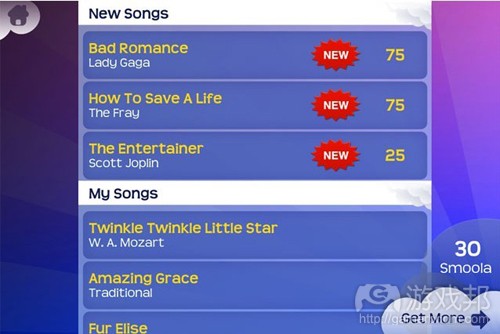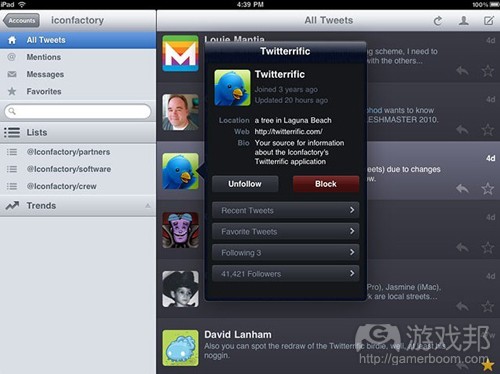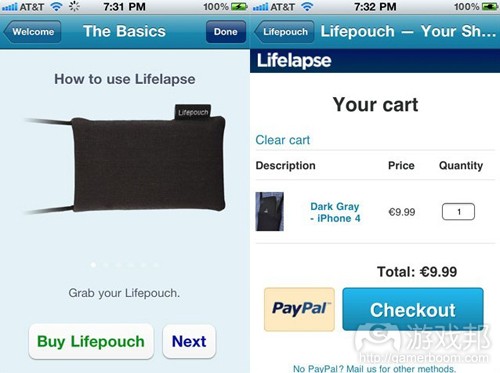简述IAP功能对应用领域的4个影响
作者:Christina Warren
应用内置付费功能(游戏邦注:in-app purchases,以下简称IAP)已经成为手机应用开发者愈加重视的一个营收渠道,被大量iPhone和Android应用所采纳,并被人们视为应用内置广告的可替代性盈利解决方案。
对许多应用开发者和用户来说,IAP或者微交易模式将对移动领域产生重要影响。以下是我们所目睹的一些已经发生的转变:
1.催生新盈利模式
IAP功能最令人兴奋的特点之一就是,它为开发者开辟了额外的营收来源,或者提供了另一种可选择的盈利模式。
例如iOS应用开发商Smule,起初发布了Magic Piano for iPad这款付费应用,一年后又发布了该应用的iPhone版本。这个新版本是免费产品,其中已含有一些歌曲,但支持用户通过虚拟货币Smoola购买Lady Gaga、Jason Mraz和布兰妮等艺人的最新曲目。
这些Smoolas分为不同的售价选项,最基本的选项是含160个Smoolas、1.99美元的内容包,可用25至75个Smoolas兑换一首歌。
这类第二货币系统在Zynga社交游戏中表现最为成功,在手机游戏领域中的典型则是Capcom的《蓝精灵村庄》,该游戏本身虽是免费产品,但却一直稳居营收榜单前列。
2.便捷访问额外内容
开发者经常使用IAP的情况之一就是在原有应用中添加额外内容。许多游戏都添加了额外的关卡内容包,并让用户另外掏钱购买。
这种做法的净效应在于,应用开发者无需在添加新关卡时,重新的发布一款应用,而用户也可以方便快捷地获取新内容,从而增加了游戏或应用的价值。
PlayFirst的iOS版本的Dash系列游戏就充分利用了这种功能,例如《Cooking Dash》游戏售价2.99美元,但额外的场景(包括10个关卡)会另外收费0.99美元。该公司会定期推出额外场景,以吸引用户时常重返游戏。
3.提供附加服务和功能
与添加额外内容模式相似,用户可以通过IAP功能“解琐”或接触应用中的额外功能。
这种附加内容可以是额外功能或工具,例如Dropbox的备份,或者更好的信息推送服务,以及解除应用内置广告的更新内容。
“无广告”选项已经被不少应用开发者广为采纳,他们希望在付费前提下,为用户提供完整的应用体验,同时又能让他们免受广告内容的干扰。
Iconfactory公司的iOS版Twitter客户端Twitterrific同时采用免费和付费两种模式。其免费版本仅支持一个Twitter帐号,并含有限量的广告内容。而4.99美元版本则支持用户使用一个以上的Twitter帐号,并且可通过IAP购买无广告的付费内容。
这对用户来说不失为一种“先试后买”的理想选择,假如他们需要更高级的功能,就可以通过IAP购买更多服务以增强应用体验。它与“简装版”模式的不同之处在于,通过IAP添加额外功能和附加服务,它不需要用户另外再下载一个应用,并且再次输入自己的个人设置。
4.销售实体商品
当然,移动领域的IAP功能并不仅局限于数字商品销售,它还支持用户购买实体商品。
亚马逊、新蛋和Target等传统的电子商务网站都采用了IAP功能,以便用户购买实体商品,假如是仅有少量实体商品的小型开发商又应如何操作呢?
这方面的范例是iPhone应用Lifelapse,其功能是每隔30秒自动通过手机拍下一张照片,以便用户回顾一整天的生活经历。该公司还搭配销售一个iPhone皮套Lifepouch,以便人们更好地捕捉生活的每个瞬间和精彩片刻。
为了在应用中提升Lifepouch的销量,开发商还在应用中绑定了Shopify网店。
据Lifelapse公司所称,20%的Lifepouch销量来自应用内置商店,并发表博文介绍了他们在应用中植入网店的操作方法,甚至还在Github上发布了相关代码。(本文为游戏邦/gamerboom.com编译,如需转载请联系:游戏邦)
4 Ways In-App Purchasing Will Change Mobile
Christina Warren
Over the last few years, in-app purchases have become an increasingly common way for mobile app developers to enhance their mobile products and services.
Most prominently available for iPhone and Android, in-app purchases often seen as an alternative to the rising trend of in-app advertisements.
For many mobile developers and users, in-app purchases — and micro-transactions in general — are going to change mobile. We’ve highlighted some of those changes and offered up some examples already in the marketplace.
1. New Business Models
One of the most exciting aspect of in-app purchase features are the additional income streams or even alternative business models that app developers can derive from the feature.
As an example, iOS developer Smule first released Magic Piano for iPad as a paid app.
A year later, when the company released a version for the iPhone, the app itself was free, along with a few songs. Each Wednesday, additional songs are released, from popular artists like Lady Gaga, Jason Mraz and Britney Spears, that users can purchase using a type of custom currency known as Smoola.
Smoolas are sold in packs starting at $1.99 for 160 Smoolas and tracks range between 25 and 75 Smoolas each.
This type of secondary currency has already proved successful for game makers like Zynga on social web platforms. On the mobile side, one of the highest grossing games for iOS is Capcom’s Smurfs Village, despite the fact that the game itself is free.
2. Easy Access to Additional Content
Perhaps the most frequent use of in-app purchase is in adding additional content to existing applications. We frequently see this in games, where additional level packs can be added to a game and purchased by the consumer after the fact.
The net effect is that the game or app maker doesn’t need to release a brand new app just to add new levels. Plus, users get access to fresh content, prolonging the value of a game or app.
PlayFirst, Inc.’s Dash series of games for iOS takes advantage of the in-app purchase feature to add additional levels and scenarios to its games. Titles like Cooking Dash [iTunes link] sell for $2.99 and additional venues (consisting of 10 levels) sell for $0.99. These venues are added over time and keep users coming back to the game.
3. Offering Add-on Services and Features
Another frequent use of in-app purchase is the add-on services or features model. Similar to the additional content model, users can “unlock” or gain access to additional features in an app by way of in-app purchase.
This can be anything from some additional features or tools — say the ability to backup to Dropbox or better push notifications — and updates can also remove in-app annoyances, like advertising.
An “ad-free” option is frequently used by app developers that want to offer users a full-featured app experience, but still want to give users the ability to choose to opt out of advertisements, for a price.
The Iconfactory’s popular Twitterrific Twitter client for iOS uses both methods. The app itself is free and works with one Twitter account and has limited advertisements. For $4.99, users can purchase the premium version within the app which removes ads and and gives users the ability to use more than one Twitter account.
This is a great way for users to sample an app and then, if they find they need more advanced features, make the decision to enhance it using in-app purchase. Unlike the “lite” model sometimes employed by app makers, adding features and add-on services via in-app purchase doesn’t require the user to download yet another app and re-enter their settings.
4. Selling Physical Goods
Of course, mobile in-app purchase doesn’t have to be limited to digital goods. Physical purchases can be made using a mobile app, too.
Sure, traditional e-commerce sites like Amazon, NewEgg and Target all have in-app purchasing for physical items, but what about smaller developers who might only have a few items available?
The iPhone app Lifelapse is designed to take an image from your phone every 30 seconds, creating a time lapse-like effect of your entire day. The company also sells a companion physical case, called the Lifepouch to better aid Lifelapsers in capturing their images and events.
To facilitate sales of the Lifepouch within the app itself, the developers found a way to integrate their existing Shopify store into the app.
Lifelapse says that 20% of Lifepouch sales come from within the in-app store, which shows how powerful it can be. The company also blogged abut how it went about integrating the shop into their app and even provided the code on Github.(source:mashable)
上一篇:以在线学习为例阐述4大游戏化要素











































 闽公网安备35020302001549号
闽公网安备35020302001549号